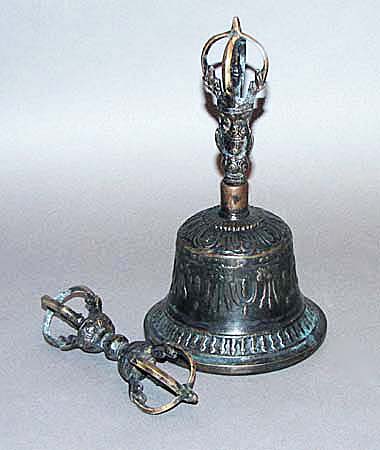
Owner: HWMC
Catalog#: AS-IDST-25-14 & AS-IDST-70-14
Bells
Tibet ‘Dril-Bu and Dorje’
Tibet, Nepal
Tibetan and Nepalese
Metal
Late 19th – Early 20th century
Bell Height: 7.75 in
Idiophones – Struck Idiophones – Bells
The dril-bu (bell) and dorje (scepter) are the most important liturgical instruments used during Tibetan Buddhist ritual recitation. They represent ‘method’ (vajra) and ‘wisdom’ (bell) and are usually regarded as one object and are matched and used together. Combined they symbolize enlightenment as they embody the union of dualities: compassion and wisdom; bliss and emptiness, appearance and reality, male and female, conventional truth and ultimate truth, etc. The face that appears on the bell’s handle is associated with Transcendent Insight. The outside of the bell is further embellished with auspicious symbols and a band of small dorjes appear at the bell’s rim.
The sound of the bell is to call to mind the empty nature of all things according to Buddha. With this understanding it allows us to become free of attachment and aversion. The bell is also used as a musical instrument played with the damara, in rituals as musical offerings to the Buddhas and other gods. Together they are used as ritual items in meditation practice, retreats, and ceremonies along with other musical instruments, mudra hand gestures and dance. The bell is held in the left hand and the scepter in the right as both hands gracefully move in prescribed gestures that serve as a commentary to the recitation.
Reference: “Dril-bu,” Mireille Helffer. “The Grove Dictionary of Musical Instruments,” 2nd ed., Vol 2., Laurence Libin, Editor in Chief. Oxford University Press. 2014
